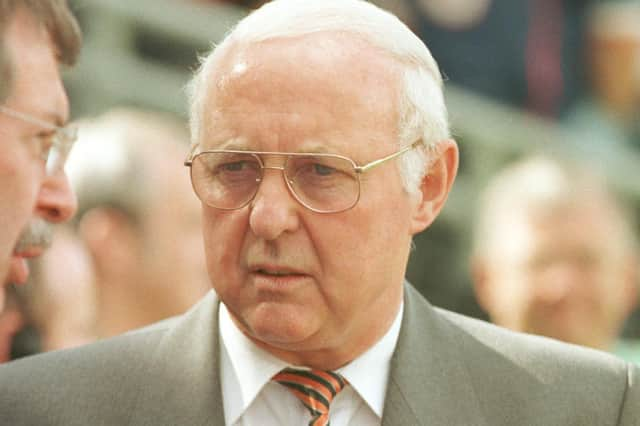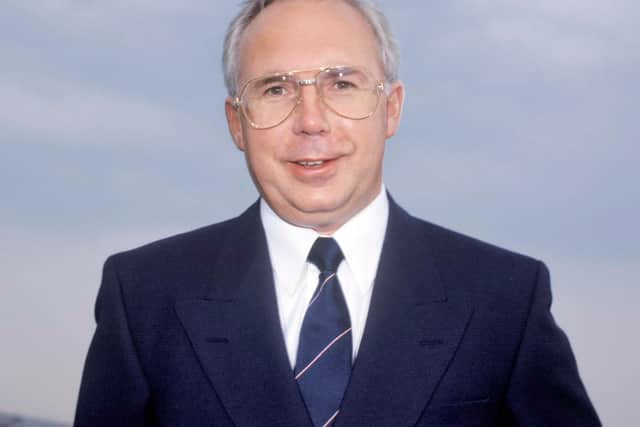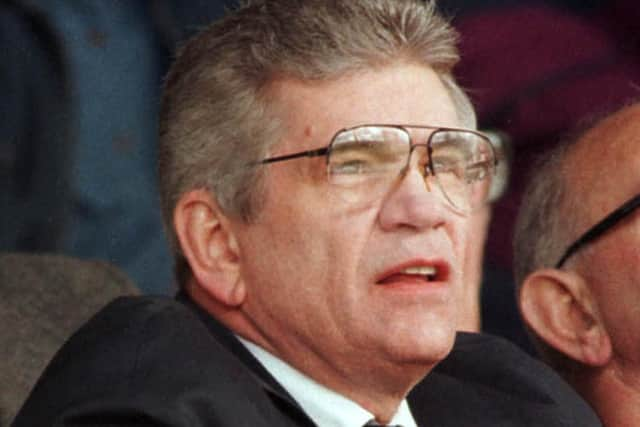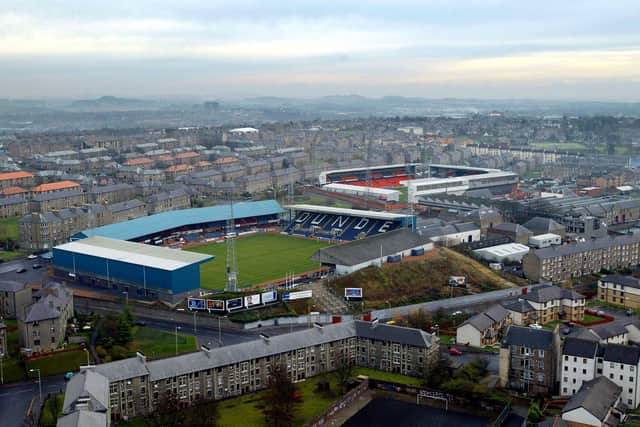How Dundee went from trying to buy Dundee United to selling a painting from Dens Park to survive


The startling news that Dundee had mounted a takeover bid for Dundee United meant the sports editor involved found it too hard to resist reaching for the file containing stock images of weddings.
McLean’s face was superimposed onto the blushing bride and further picture doctoring meant the handsome groom was now a bespectacled grey haired man called Angus Cook, the then chairman of Dundee.
Advertisement
Hide AdAdvertisement
Hide AdThe upshot was that Scotland on Sunday sports writers were paying to get into Dundee United matches for a prolonged spell. McLean, then operating in the unusual dual role of manager/chairman, was not amused by the newspaper’s lack of respect. "I do remember there were some afters from Mr McLean," says reporter Andrew Malone. "I seem to recall he went berserk."


What had made McLean laugh was Cook’s conceit. Twelve months after Hearts chairman Wallace Mercer's hostile takeover of Hibs had been repelled, Cook was attempting an even more ambitious move. Except on this occasion, the aggressor was a club then perceived to be the lesser lights in the city. Indeed, they were in the division below United who, just weeks earlier, had contested a classic Scottish Cup final against Motherwell.
Dundee, on the other hand, had fallen short in their bid to return to the top flight at the first attempt and were trying to prevent being cast as a yo-yo club following a third relegation since reconstruction.
It’s a reputation they have firmly established in recent decades. However, their latest promotion, following last week’s play-off victory over Kilmarnock, at least ensures that the Dundee derby will return to the top-flight after an absence of five years.
One of the few games in Scotland that is guaranteed to sell out, whether it is on television or not, the clash is a supremely welcome addition to the schedule. And yet, if a diminutive man with a big dream called Angus managed to have his way, there would be no Dundee derbies taking place next season in the Premiership, or anywhere else. The fixture would be a relic of a distant age.


Instead, Dundee City Football Club would be one of the main forces in the land having eclipsed the might of the Old Firm to establish a new footballing power base by the Tay. At least that was how Cook tried to sell his ambitious plan to the Dundee public. The way he saw it, if two clubs in the same city had been able to reach European Cup semi-finals, then think how far one club could go.
Now in his mid-70s, Cook still lives in Dundee. Contacted for this story, he declined to say anything on the record because whatever he said would be “misinterpreted”. The backlash from 30 years ago has left its mark.
He says he has not been back to a match at Dens Park since selling his shares four months after the takeover attempt which had angered Dundee fans as much as it did those of United. His actions inspired the creation of the Dundee Shareholders’ Association, formed to try to prevent Cook or anyone else running roughshod over the will of the supporters. The former chairman now deals in sports memorabilia among other things and lives in a house overlooking the Tay.
Advertisement
Hide AdAdvertisement
Hide AdA lot of water has since flowed under the bridge and yet even to this day he is portrayed as the man who risked ruining football in Dundee. He might well reply that he was not involved when the Dens Park club later suffered two administrations. By buying Dundee United, he was trying to ward off the threat of impending financial collapse.


If there was some logic to his thinking his plans certainly did not account for the fans’ passion. Very few, if any, were willing to watch a reconstituted single club playing out of Dens Park, as was the plan at the time. “Dundee United should concede as everyone else agrees, that the true stadium of the city is Dens Park,” Cook told the Sunday Times.
He based this on the fact that the site had far greater acreage as well as 12,000 seats, more than enough to comply with the Lord Justice Taylor Report following Hillsborough.
This weekend is the 30th anniversary of the aborted takeover – and takeover is what it was. “Angus tried to word it as a merger but if you looked at the paperwork it was clearly a takeover,” says Steve Martin, one of the founders of the Shareholders’ Association and a former Dundee director. “And you don’t do that to Jim McLean, do you?”
McLean treated the bid with the disdain expected. Cook viewed United’s share structure as “not impregnable” to a takeover situation and was offering £300 a share. “£4m? It wouldn’t even buy the youth team at this club,” McLean told reporters at a hastily convened press conference on 31 May 1991, after Cook’s offer became public.
“Sling Your Hook Cap’N Cook!” was the headline on the front page of the Daily Record thirty years ago today. It signalled another summer of strife in Scottish football following Mo Johnston’s transfer to Rangers two years earlier and then 1990’s proposed Edinburgh clubs’ merger.
McLean used Hearts chairman Wallace Mercer’s thwarted takeover of Hibs the previous summer as a reference point. He argued that if the Easter Road club, with reported financial difficulties and a less successful playing record, had been valued at £4.25m by Mercer, United should be worth far, far more. Not that this was the point.
Although informal discussions had in fact taken place between the clubs about merging or at least sharing a stadium, Cook’s offer, which amounted to a Dundee takeover of their rivals, was a most unwelcome development. Cook claimed to have registered a company called Dundee City Football Club Ltd two years earlier, pre-dating even Mercer’s merger attempt.
Advertisement
Hide AdAdvertisement
Hide AdAs in Edinburgh, opposition was fierce. However, Martin is surprisingly generous towards Cook. "I think he was confused by Wallace Mercer - he was his hero to be honest. Anything Wallace did, he seemed to follow.”
Cook did disagree with Mercer about one thing. He felt Edinburgh could “just about” support two teams, but Dundee, with its population of 175,000, could not. “He was a tough wee cookie, a typical wee Dundee guy – a self-made man if you want to call it that,” added Martin. “I respected him.
"He was just a bit above his station – he did not quite have the finance behind him. He wasn’t the first to be guilty of that and he won’t be the last.”
Ron Dixon, the next-but-one owner following a strange interlude when Cook’s lawyer Andrew Drummond was installed as chairman, proved an even more colourful landlord. He claimed he had a licence to carry a gun with him due to his business connections in Russia.
He resolved to buy Dundee after spotting Cook’s Rolls Royce sitting outside Dens Park, having concluded that this was a reasonable sign that the club must be faring well financially.
After some initial excitement, Dixon turned the funding tap off and left Dundee high and dry. By 1996, they were reduced to selling the family jewels – or in this case, an original painting by William McTaggart, bought by Dixon for £40,000 – just to stay afloat.
Current director Bob Hynd recalls removing the artwork, depicting a scene at Machrihanish, from the boardroom wall before the bailiffs did and then, on Dixon’s say so, selling it to pay the latest round of bills. Hynd recruited a reputable firm of auctioneers but suspects he – or at least the club – ended up being diddled.
“Off the top of my head, it went for £25,000,” he recalls. “I always regretted it. It really gave an air of quality to the boardroom.”
A message from the Editor:Thank you for reading this article. We're more reliant on your support than ever as the shift in consumer habits brought about by Coronavirus impacts our advertisers.If you haven't already, please consider supporting our trusted, fact-checked journalism by taking out a digital subscription https://www.scotsman.com/subscriptions
Comments
Want to join the conversation? Please or to comment on this article.